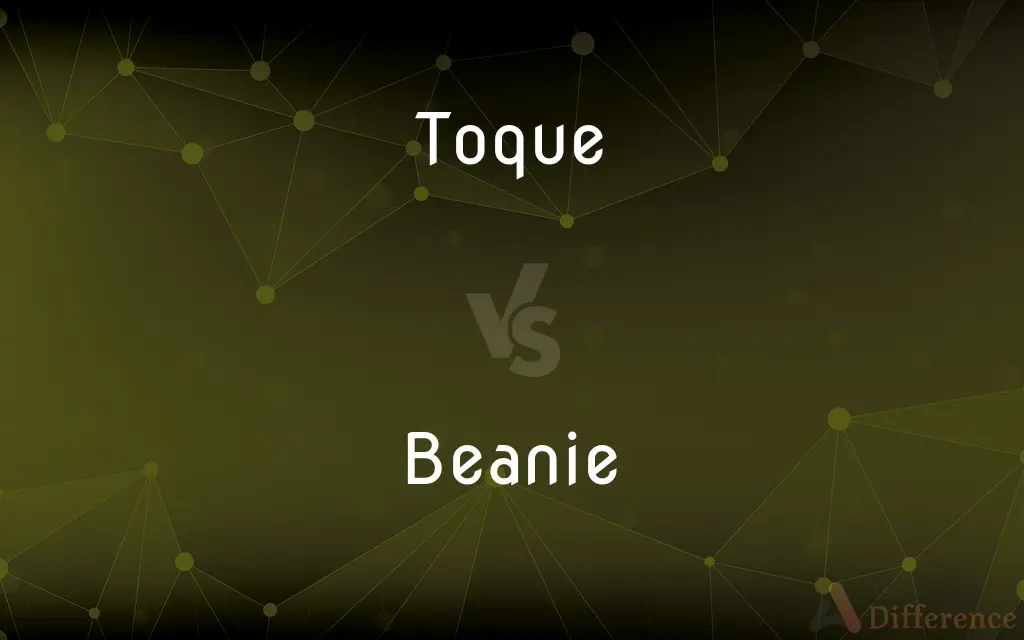Toque vs. Beanie — What's the Difference?
Edited by Tayyaba Rehman — By Maham Liaqat — Updated on April 23, 2024
Toques are often chef's hats with a distinct tall, pleated design, signaling culinary professionalism; beanies are casual, close-fitting knit caps, typically worn for warmth.

Difference Between Toque and Beanie
Table of Contents
ADVERTISEMENT
Key Differences
Toques are traditionally associated with culinary professionals, featuring a distinct, often white and pleated design, symbolizing cleanliness and expertise in cooking. Whereas, beanies are popular casual wear, made of knitted material and primarily worn for warmth during colder months.
Toques can come in various heights and styles, but they maintain a standard of being tall and sometimes stiffened to hold their shape. On the other hand, beanies are characterized by their elastic and soft nature, which allows them to be pulled down over the ears.
While toques are predominantly used in professional kitchens and culinary schools, emphasizing a chef’s rank and the hierarchy within the kitchen, beanies serve a more utilitarian purpose in everyday life, offering comfort and warmth, and are a staple in urban and winter fashion.
In culinary settings, toques may be required as part of a uniform, helping to prevent hair from contaminating food. Whereas, beanies are worn more for personal style or weather needs, lacking any professional connotations.
Despite both being types of headwear, toques and beanies serve very different functions and represent different cultural significances: toques in professional culinary arts, beanies in casual, everyday apparel.
ADVERTISEMENT
Comparison Chart
Primary Use
Professional kitchens, culinary symbol
Casual wear, warmth
Material
Often stiffened fabric
Typically knitted yarn or wool
Design Features
Tall, pleated, sometimes with a pompom on top
Close-fitting, stretchable, often with a cuff
Cultural Significance
Symbol of culinary professionalism
Associated with casual or sporty lifestyles
Variations
May vary in height and style among professionals
Comes in various colors and patterns
Compare with Definitions
Toque
Historically, a type of woman's hat popular in the 13th to 16th centuries.
The portrait featured a noblewoman adorned with a velvet toque.
Beanie
Sometimes includes decorative elements like pompoms.
Her new beanie had a large fluffy pompom on top.
Toque
A soft, round, and somewhat brimless hat often worn for warmth.
Her toque was adorned with a handmade flower.
Beanie
A close-fitting knitted cap, often woolen, worn for warmth.
She wore her favorite beanie to keep warm during the winter hike.
Toque
In Canada, a knitted winter hat, similar to a beanie.
He pulled on his toque before heading out into the snow.
Beanie
Often part of urban and youth fashion.
He styled his outfit with a bright red beanie to add a pop of color.
Toque
A tall, brimless, pleated chef's hat used as a culinary uniform.
The head chef wore a pristine white toque as he prepared the courses.
Beanie
Popular among outdoor enthusiasts.
Every skier at the resort had a colorful beanie.
Toque
A symbol of rank in professional kitchens.
The number of pleats on his toque indicated his years of experience.
Beanie
A cap without a brim.
His beanie collection includes a variety of colors and patterns.
Toque
A toque ( or ) is a type of hat with a narrow brim or no brim at all.Toques were popular from the 13th to the 16th century in Europe, especially France. The mode was revived in the 1930s.
Beanie
A snug, knitted, brimless cap that usually covers the ears.
Toque
A usually black, velvet cap with a narrow, rolled brim and often an ornamental plume, worn especially in France in the 16th century.
Beanie
A small brimless cap.
Toque
See tuque.
Beanie
A cap that fits the head closely, usually knitted from wool.
Toque
A hat, usually white, having a tall pleated crown and no brim and traditionally worn by chefs.
Beanie
A head-hugging brimless cap, with or without a visor, made from triangular sections of cloth, leather, or silk joined by a button at the crown and seamed together around the sides.
Toque
A type of hat with no brim.
Beanie
(informal) A Beanie Baby, a small soft toy filled with beans or similar stuffing.
Toque
(specifically) A tall white hat with no brim of the sort worn by chefs
Beanie
A small skullcap; formerly worn by schoolboys and college freshmen.
Toque
A chef.
Beanie
A small skullcap; formerly worn by schoolboys and college freshmen
Toque
A variety of bonnet monkey; toque macaque, Macaca sinica.
Toque
(historical) An African nominal money of account, equal to 40 cowries.
Toque
(Canada) A knitted hat, usually conical but of varying shape, often woollen, and sometimes topped by a pom-pom or tassel.
Toque
(music) A rhythm used in Latin music, especially Cuban religious rituals.
Toque
(music) The guitar part of flamenco music.
Toque
A kind of cap worn in the 16th century, and copied in modern fashions; - called also toquet.
His velvet toque stuck as airily as ever upon the side of his head.
Toque
A variety of the bonnet monkey.
Toque
A tall white hat with a pouched crown; worn by chefs
Toque
A small round woman's hat
Common Curiosities
How do chefs choose their toques?
Chefs might choose their toques based on kitchen requirements, personal style, or the significance of the toque's design, such as the number of pleats, which can signify experience.
What is a toque?
A toque is a type of hat with different meanings: in culinary contexts, it refers to a tall, pleated chef's hat; in Canadian English, it means a knitted winter hat similar to a beanie.
Why do people wear beanies?
People wear beanies for warmth, comfort, and as a fashion statement, especially in colder climates.
Are beanies suitable for all seasons?
Beanies are generally worn in colder seasons due to their warm, knitted materials, but lighter versions may be worn in cooler parts of spring or fall.
What is a beanie?
A beanie is a close-fitting knitted cap, often made from wool, worn primarily for warmth and as a fashion accessory.
Are toques and beanies the same in Canada?
In Canadian English, "toque" can refer to what is commonly known as a beanie in other parts of the world, making them synonymous in that context.
How often should a toque be replaced?
A toque should be replaced when it shows signs of wear or when it no longer maintains its shape and cleanliness, especially in professional settings.
Can beanies be part of a professional uniform?
Beanies are not typically part of a professional uniform outside of outdoor or casual work environments.
Can a toque have a pompom?
Yes, some toques, especially those used in professional kitchens, might have a pompom on top, though it is more common in the Canadian version of a toque.
How do you care for a beanie?
Beanies made from wool or cotton should be hand-washed or machine washed on a gentle cycle and air-dried to prevent shrinking.
What are some popular styles of beanies?
Popular styles of beanies include cuffed beanies, slouchy beanies, and those with or without pompoms.
Do toques signify anything in the culinary world?
Yes, toques can signify a chef's rank or experience, particularly through features like the number of pleats.
How do you care for a toque?
Care for a toque depends on its material, but generally, it involves gentle washing and avoiding high heat to maintain its shape.
What materials are beanies made from?
Beanies are typically made from materials like wool, cotton, or synthetic fibers that provide insulation and stretch.
Share Your Discovery

Previous Comparison
Pine vs. Cypress
Next Comparison
Locale vs. LocalAuthor Spotlight
Written by
Maham LiaqatEdited by
Tayyaba RehmanTayyaba Rehman is a distinguished writer, currently serving as a primary contributor to askdifference.com. As a researcher in semantics and etymology, Tayyaba's passion for the complexity of languages and their distinctions has found a perfect home on the platform. Tayyaba delves into the intricacies of language, distinguishing between commonly confused words and phrases, thereby providing clarity for readers worldwide.














































